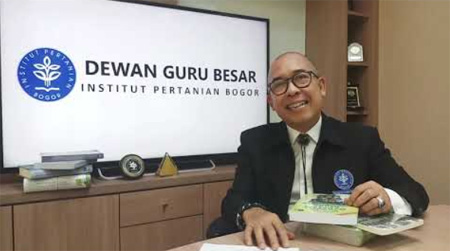Vetiver Planting to Prevent Landslides, This Said a Lecturer of IPB University

As an effort to mitigate disasters, especially landslides, there is a discourse to plant vetiver or fragrant roots in landslide-prone areas. However, these mitigation efforts must be planned in a transdisciplinary and integrated manner.
According to Professor of IPB University in the field of Ecology and Landscape Management, Prof. Dr. Hadi Susilo Arifin, there are many plants that can be carried as erosion prevention plants. One of them is the fragrant root plant (Vetiveria zizanioides) which is known by its popular name as vetiver. Vetiver is a plant that has roots that are up to two meters long into the ground, which is very effective in gripping the soil so that it does not slide easily. But on the other hand, this plant is actually harvested roots for raw materials for making essential oils.
Therefore, the zoning process must be made in such a way that the harvesting period does not coincide. In addition, plant cultivation techniques, community culture of plants to be used, capacity building for upstream and middle communities, extension of social, economic benefits of the plants carried and engineering techniques in crop cultivation also need to be considered. Actually the right solution in the upstream and middle regions to prevent erosion is to empower vetiver planting with agroforestry techniques, "he said.
This planting technique is loaded with local knowledge and local wisdom. The vetiver intercropping system is combined with tree stands. It can be fruit trees, medicinal plants or vegetable producing plants. Vetiver will become a perennial crop, especially for areas with high slope slopes. Meanwhile, flat areas can use a monoculture system. Some tree stands that have the potential to protect land use, water systems and even air systems (carbon sinks) are sugar palm, putat, gayam, saninten, petai and jengkol as well as forest nutmegs. These trees have high economic potential.
Associated with the customs and culture of the community, plants that are commonly planted by the community will be easy to be empowered in environmental control. But if they are not used to and or do not have a culture of growing these commodities, intensive counseling must be done both on cultivation techniques, aspects of harvesting and post-harvest processing, agro-industry, marketing and agribusiness, "he added.
As for engineering, Prof. Hadi suggested making several treatments on upstream and middle agricultural land. For example, by making patio benches, swales and mounds. This treatment can also be done at the same time with the practice of alley cropping, which is the aisle system, both complex agroforestry and simple agroforestry. (IAAS/NAS)



